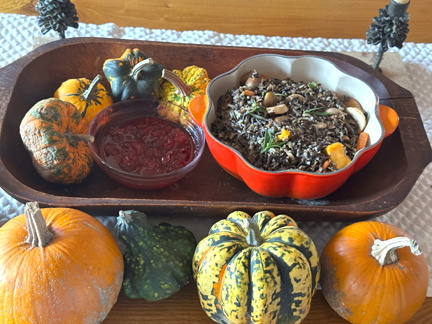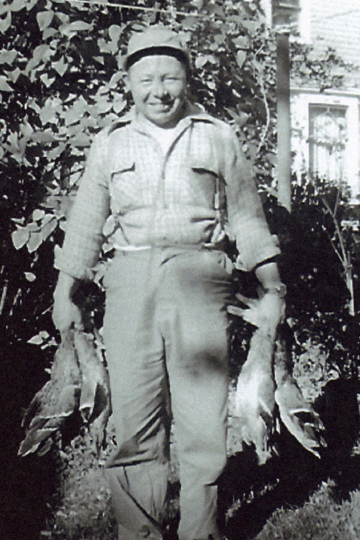
Last year at about this time, I sent out a Facebook post asking friends to share their favorite Thanksgiving recipes. I quickly found one—and later saw a reply from my friend Marianne Schultz. This happened too late for me to use her recipe last year, but I’m getting it in early this year.
Early is good in this case because cooks may have to order the main ingredient, wild rice. It’s not easy to find in these parts. Marianne recommends ordering it from Lunds & Byerlys in Minnesota. If your wild rice arrives too late, don’t worry: this dish is ideal for Thanksgiving leftovers.
Marianne doesn’t use the name “wild rice.” She calls this grain, and the dish she makes with it, manomin. Spelled in a variety of ways, often manoomin, the word means “good berry.” Manomin is possibly the only grain native to North America. Native Americans have consumed it for more than 1000 years.
As many readers probably know, wild rice isn’t a rice at all. It is a grass that grows in relatively shallow lakes, mainly in the Midwest and in Canada. Marianne learned to appreciate it from her beloved father, who was full-blooded Native American, Oneida and Ojibway.
Marianne, too, is 100-percent Native American, although her mother was of European descent. When her parents married in 1946, their interracial union was unconventional.
Marianne was adopted when she was nine months old. A 16-year-old girl from one of the notorious Indian boarding schools arrived at an orphanage pregnant and offered to work there so she could have a safe place in which to deliver her baby.
Marianne’s parents had been looking for a Native-American baby. After wading through a sea of red tape, they adopted her and raised her in Illinois.
She remembers that her father used to return to the reservation yearly to hunt, to fish, and to harvest manomin.

Marianne’s Father
He was a decorated pilot in World War II who worked for American Airlines after the war, although a friend had to sign papers to get him into the job because he didn’t meet the airline’s height requirement.
Marianne’s father harvested wild rice by canoe. The harvest was a two-person job, she told me. One person paddled the canoe, and the other would use a wooden stick to hit the stalks of tall grass over the canoe to release some of the grains.
Even after the harvest, manomin was a lot of work, Marianne recalled. “It would come in brown paper bags completely in its off-the-stalk format. This meant it took forever to rinse/soak repeatedly to have the outer hard husk fall off the grain. It was always such a treat, and I am glad I can say that is how we got ours.”
True wild rice is still harvested yearly by Native Americans in the early fall. Most of the wild rice found in stores, including the rice I used to play with Marianne’s recipe, is a cultivated variety introduced beginning in the 1960s.
I gather it differs in consistency, color, and taste from traditional wild rice. It is still highly nutritious, however, with an appealing nutty flavor. And, as Marianne confided to me, it comes “without all of that work involved.”
Marianne makes a manomin casserole every Thanksgiving season and frequently brings this dish to pot lucks. She freely admitted to me that her recipe isn’t exactly a recipe.
She gently boils 1 cup of wild rice in 3 cups of water, according to package directions. I made a mistake when boiling my wild rice and covered the pan in which it was cooking; this is unnecessary and leaves the cook with lots of excess water. (I kept a little for my casserole and discarded the rest.)
The boiling process took me about 45 minutes. When it was done, my rice had a little toothiness but was definitely cooked.
Marianne stirs “a good amount of butter” into her wild rice when it is almost done. (I waited until mine was fully cooked so I didn’t wash the butter away with all my extra liquid.)
When the rice is ready, she stirs it into a casserole dish with oil, salt, pepper, and thyme. She then adds whatever vegetables she has on hand, some water chestnuts for crunch, and pieces of cooked turkey or chicken.
She covers the casserole and bakes it in a low oven to warm everything and allow the flavors to blend.
Marianne lives in Hawaii, where it is currently pomegranate season. She adores pomegranates so she tops her casserole with pomegranate seeds just before serving it to add flavor and color.
With Marianne’s permission, I made the manomin casserole my own. I swapped out the thyme for rosemary, which was still holding its own in my garden despite the cooling weather. (My thyme was under the snow.)
Not finding any pomegranates in my local general store, I opted instead for the red pearls currently available here in New England and served a little cranberry sauce on the side of my casserole. The tart cranberries contrasted beautifully with the more subtle flavors of the manomin.
Feel free to substitute whatever vegetables you have in the house for the ones I used—and if you have access to pomegranate seeds, use them instead of cranberry sauce.
Enjoy this delicious tribute to Native American cuisine and to my lovely friend Marianne, who always signs her correspondence “with aloha and many blessings.” Happy Thanksgiving!

Marianne and Her Father at her Wedding in 1982
Manomin
Ingredients:
1 cup wild rice
3 cups water or stock
salt as needed
1/4 cup (1/2 stick) butter
pepper as needed
fresh or dried herbs to taste (I used fresh rosemary)
a splash of extra-virgin olive oil
4 cups cooked (or if you like, in the case of celery and carrots, raw) vegetables
(I used 1 small honeynut squash, roasted in with a little olive oil, salt, and pepper, and cut up; 3/4 cup baby carrots, also roasted with a little olive oil, salt, and pepper; and 10 ounces mushrooms, sliced and sautéed in a little butter)
2 cups (more if you like) chopped cooked chicken or turkey (pressed and sautéed tofu would work if you’re vegetarian)
Instructions:
In a 3-quart saucepan, bring the rice, the water or stock, and a pinch of salt to a boil. Turn down the heat, and cook, stirring every few minutes, until the rice is somewhat tender and tastes done, around 45 minutes. While the wild rice is cooking, preheat the oven to 325 degrees.
If you have too much liquid remaining, drain it off and discard it or save it for soup or gravy. Stir in the butter, a bit more salt, pepper to taste, and the herbs. Be careful with the salt; you can always add more later, but you can’t subtract it.
Stir in the oil, the vegetables, and the chicken or turkey. Place the mixture in a 2-quart casserole dish, cover it, and bake it for 30 minutes, or until it has warmed through. Serve with cranberry sauce. Serves 6 to 8.


